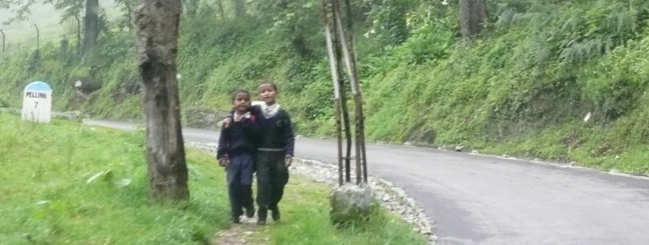Save Money, Guard Your Brain, Prevent Cancer
& Enjoy Better Sex – By Walking
If you’re one of the staggering 39.9% of the population that spends most of your day sitting on your backside, then I’m going to get you on your feet and moving. That’s why I’m writing this article about the astonishing benefits of walking.
Look, I understand how stressful and hectic your daily routine is. None of us have time to spare for exercise or recreation any more. And, after all, taking the lift or escalator is quicker than climbing the stairs, driving or catching a taxi or bus can get you there sooner, and the streets are truly dangerous for walking with crumbling sidewalks, crowds and the dust or smog.
Still, there’s a compelling case to go walking. In fact, in a shocking health warning to the sedentary masses, the Surgeon General’s report suggests that significant health benefits are possible from just “ceasing to sit and starting to move”.

Why Should You Bother With Walking?
Would you believe it if I told you that you’ll save money, guard your brain, prevent cancer and have better sex by walking regularly?
Well, start believing!
Walking brings you many health benefits. Walking controls diabetes and heart disease. It lowers blood pressure, increases bone density and improves overall fitness.
- Walking for 150 minutes every week can cut your diabetes risk by almost two-thirds by improving insulin sensitivity.
- Older men who walk a couple of miles daily are twice as likely to live longer than their peers who don’t go walking.
- Walking will soup up your sex life. Women between 45 and 55 years of age who were brisk walkers report greater sex drive and better sexual satisfaction.
- Women who walk 3 hours or more in a week cut heart attack risk by 35%… and are also mentally agile, with better memories.
- Walking just a mile every day gives post-menopausal women denser bones and they have fewer fractures, aches and pains.
- A daily half hour walk will keep you from getting depressed!
- Walking helps prevent cancer of the breast and colon, improves fitness, and lowers body fat.
- You’ll even save money by walking – on gym costs, medication and treatment expenses. Regular walkers often cancel their gym memberships.
- Walking can get you off medicines. The National Walkers Health Study shows that people who take long walks are often less likely to need any medication.
- Walking relieves chronic pain from medical conditions including fibromyalgia.
Still think walking is for crazy people?
If you’re not jumping off your couch to go for a walk, then I hope you’re at least squirming a little in discomfort – and thinking about walking more seriously than you ever have before!
Is Walking Really Exercise?
Many cynics think that walking isn’t really exercise. Well, I have news for them!
- Walking at 3 mph or faster gets your entire body moving – legs, hips, arms, torso, everything. It’s the ultimate aerobic exercise workout program!
- In fact, studies about how much oxygen the body consumes have proved that brisk walking is only marginally less intense than running or jogging.
- Like other aerobic activities, walking burns calories and can help you lose weight. Just burn more calories than you consume, and you’ll win that battle of the bulge!
- More interesting is the fact that walking can help maintain weight after you lose excess fat. Following weight loss, those who exercise and walk regularly are more likely to keep off those extra pounds than others who return back to a lazy lifestyle. The National Weight Control Registry has over 5,000 members who have maintained a 30-pound weight loss for a full year – just by walking regularly.

How to Walk – The Different Types of Walking
There’s race walking, which is a sport with specific rules (e.g. your feet must constantly be in touch with the ground). And there’s power-walking which is what most elite walkers practice.
But for most couch potatoes, there’s just plain ol’ walking.
Getting up. Putting one foot in front of the other. Repeating it.
Even that’s good enough – if you do it consistently. And correctly.
Here are some tips for effective walking:
- Keep your stride short. Longer strides may help you walk faster, but it is inefficient and you’ll tire sooner.
- Walk heel to toe, not flat footed. Let your heel strike the ground first with each step, and roll your feet forward to push off with your toes.
- Keep your body straight and upright instead of leaning forwards or backwards.
- Your arms must be relaxed and held by your side, flexed at the elbow, smoothly swinging as you walk along.
Your Feet, Your Shoes & Your Walking
Not everyone is cut out for the same kind of walking. A lot depends upon the type of feet you have. A quick way to tell is by looking at your shoes to see their wear pattern. Another method is to wet your feet, step on a dry surface and observe the imprint.
Most of your foot may touch the floor (pronator feet), or only a little of it may (supinator feet). All ranges in between are possible. This matters because your footwear must suit your feet type.
Walking shoes have rounded heels and toes to let you push off powerfully. Soles should be flexible and bend easily. Soft, bouncy and over-cushioned shoes are not good for walking. Arch supports can help those with pronator feet. Good walking shoes absorb shocks, which prevents your feet hurting after a long walk.
Shoes that ‘breathe’ are better for your feet. Some have holes. Mesh fabrics work better than leather.
Try on your walking shoes to see if they are comfortable. Even minor irregularities can cause blisters and make walking uncomfortable or painful.
Buying walking shoes is an important element of your exercise routine. Make sure you pick the right ones and wear socks that don’t compress and absorb moisture.

How To Count The Calories Burned Walking?
There isn’t a formula to compute the number of calories you’ll burn off by walking. As a rough and ready rule of thumb, a walker who weighs 150 pounds will lose 100 calories for every mile walked.
There are many charts available to help you estimate the calories burned walking per mile, depending upon your weight and speed of walking. Running is just as effective as walking to burn calories, just faster.
A brisk walking speed is 3 to 4 miles per hour. If you’ve not been exercising regularly, you may have to begin at a slower pace. But you’ll quickly build up to this ideal level. Walking indoors on a treadmill is just as beneficial as walking outdoors.
How Much Walking Must You Do?
10,000 steps of walking, jogging or running every day is the ‘Golden Rule’. A two-mile walk provides 50% of this requirement.
The Surgeon General of US recommends 30 minutes or more of moderately intense physical activity, for at least 5 days every week. This duration is cumulative over the course of your day, so you can exercise in shorter bursts and repeat it at intervals throughout the day.
What does ‘moderately intense’ mean? Well, it should leave you feeling warm and a little out of breath, though not gasping for it or sweating buckets!
It’s easy to fit in a short stint of walking into your regular routine, just by being a little creative.
- Get off the bus a stop earlier than your destination and walk the remaining distance.
- Park a block away from the office or store and walk.
- Don’t order your food or coffee sent in – walk to the cafeteria or deli for it.
- If you’re running errands in the neighborhood, don’t drive – go walking.
- Mow the lawn with a push-style mower.
- Have walking shoes handy at multiple locations so that you can walk whenever the mood hits you.
A simple plan is to set out and walk for five minutes, then turn back and return to where you started from. Gradually, every week, extend this by 2 or 3 minutes. Before you even notice it, you’ll be up to a brisk 30 minute walk every day.
There’s one danger with this system – you may not try it because it sounds “too simple”!
Trust me, it’s an effective way to begin walking… and keep walking. 85% of fitness enthusiasts who start out this way continue walking regularly – a year later.
Power walking is the natural next step. This may require that you find a suitable place to walk fast, or get a treadmill for indoors walking, or even join a gym or fitness club.
Once you’re comfortable with 30 minutes of power walking, you can boost this with interval training where you push your body to higher levels of walking for short bursts (“work”) and then slow down to a more comfortable pace for some time (“active rest”).
A good routine may be to walk at normal speed for 3 minutes, then walk very fast for a minute, drop back to regular speed for another three and repeat this cycle for the duration of your walking session.

Where To Go Walking?
You can go walking anywhere. Literally.
A major problem for many people who begin walking is that the enthusiasm fades and they find it hard to stay motivated. When you get started, don’t worry too much about where to walk or for how long. Just do it!
Planning your walks is a good way around this problem.
Write down your proposed walking schedule. Jot down the days of the week you’re going to walk.
- What time will you go?
- How long will you walk?
- Where will you go?
Walking doesn’t need many resources. A decent pair of shoes, some spare time, and you’re good to go!
- You can explore your town or city by walking into new areas.
- You can walk around your own block or neighborhood, following a routine.
- You can go walking in parks, tracks or grounds.
- You can join walking tours, mix learning with exercise.
- You can walk in a mall or shopping complex, even in bad weather.
- You can choose walking trails that many others also follow.
- You can participate in walking clubs or even compete in walking races.
- You can walk for charitable causes in your area.
All these options – and more – are available when you’re serious about walking.
What matters most is making the decision to walk… and then sticking to it!
Go on, then. Take a walk.
